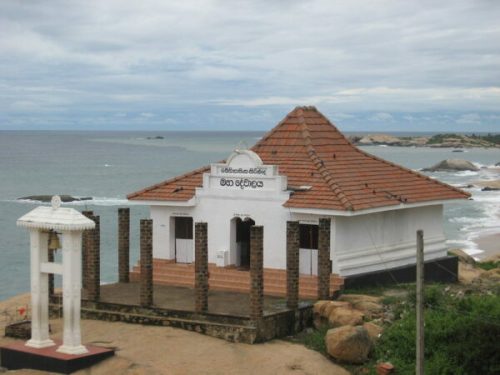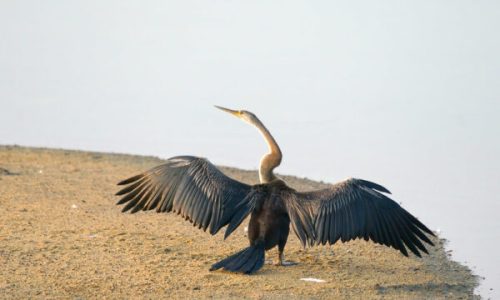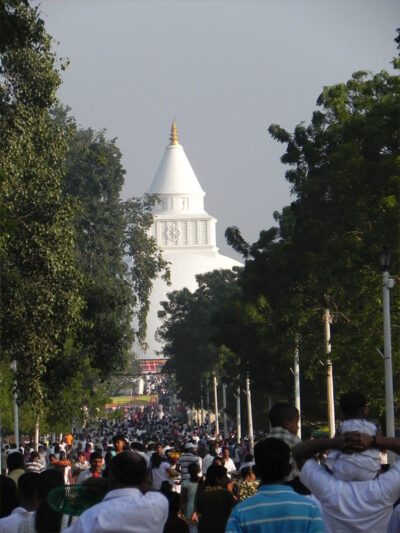Located 30 kilometers from the Mattala exit of the Southern Expressway and 270 kilometers from Colombo, Tissamaharama is a town in the southern province of Sri Lanka. The city serves as a hub for both local and international tourist excursions due to its placement as the entry point for journeys to Yala National Park and Kataragama.
Despite being the entrance to Yala National Park, Tissamaharama is a significant cultural and natural destination. Tissamaharama is worth seeing since it has two historic irrigation reservoirs and three historic stupas.
History of Tissamaharama
Prince Mahanaga, the brother of King Devanampiyatissa, created Tissamaharama, also known as Mahagama, the capital of the southern region of Sri Lanka, in the third century BC.
King Kavantissa, King Dutugamunu’s father built the two historic irrigation reservoirs and the three stupas of Tissmaharama. The records state that during the reign of King Kavantissa, over 12,000 Arahats Buddhist monks resided in Tissamaharama and its vicinity.
15 Best Places To Visit In Colombo
- Tissa Wewa
- Tissamaharama Temple
- Yatala Temple
- Kirinda Maha Devalaya
- Kirinda Beach
- Yala national Park
- Bundala National Park
- Udawalawe National park
- Udawalawe Elephant Transfer Home
- Kataragama Devalaya
- Sella Kataragama Dewalaya
- Kiri Wehera Temple
- Situlpawwa Rock Temple
- Hambantota Dry Zone Garden
- Hambantota Saltern
01. Tissa wewa
Tissa Wewa, located on the tissamaharama kataragama route, is a picturesque spot to spend your afternoon or just stop by on your way to Kataragama. There is also a boat ride service at Tissa Wewa for those who want to go on a boat safari and see the birds nestling on Tissa Wewa. Swimming in the Wewa is not recommended as there are reports of crocodile attacks.
This manmade reservoir, one of four large historic irrigation tanks in the area, is said to have been built in the 3rd century BC by King Maha Naga to irrigate rice fields and give water to the booming city of Tissamaharama.

02. Tissamaharama Temple
This sky-touching temple, located in the middle of a padyfield, is a wonderful spot to unwind when visiting Tissamaharama. Furthermore, if you go on a poya day, a special holiday which occurs once a month, you will observe Buddhist devotees gathered around the stupa and worshiping their mentor Lord Buddha with honor.
Tissamaharama temple, with a height of 156 feet and a circumference of 550 feet, is one of the sixteen most holy sites in Sri Lanka for Buddhist pilgrims. It was one of four main Buddhist monasteries constructed in Sri Lanka following the advent of Arhant Mahinda Thera.
According to the historian, king Mahanaga constructed the Tissamaharama temple, also known as Tissamaharama raja maha vihara, in the third century BC. And in the second century BC, king Kavan Tissa expanded the monastery into a significant temple.

03. Yatala Temple
One of my favorite places to visit during my time in Tissamaharama is Yatala Temple. Anyone traveling on Tissa Kirinda road may view the Dagoba situated on the side of the road. All you have to do is park your vehicle on the side of the road and just step up there, being sure to remove your shoes as you do so.
If you are interested in history, Yatala Temple includes a modest museum with several artifacts that can help you learn about Sri Lanka’s past.
The stupa, also referred as Mani Chethiya and Yattalaya is thought to have been built 2300 years ago by regional ruler Yatala Thissa of Ruhuna to commemorate the birth of Yatala Thissa’s father, regional ruler Mahanaga.

04. Kirinda Raja Maha Vihara
Kirinda Rajamaha Viharaya is accessible through the Tissa-Kirinda road. This temple is situated on the peak of a rocky mountain near Sri Lanka’s southern coast. Because of its location, this temple provides a spectacular view of the sand dunes beach, and the surrounding area.
Kirinda Rajamaha Viharaya is where the princess Viharamaha Devi disembarked from her heroic voyage on the sea. the princess had chosen to sacrifice herself to quiet the raging waters, which had, in reality, inspired her voyage and was met by King Kavantissa and his attendants.
At its peak, you’ll find sculptures of Lord Buddha and Queen Viharamahadevi, as well as a Stupa, the Devalaya, a Bo tree and its temple.

05. Kirinda Beach
Kirinda Beach is a tranquil setting in the heart of a fishing community, a 10-minute walk from the Kirinda Buddhist Temple and a 20-minute drive from Yala National Park. However, during weekends and local holidays, the Kirinda beach is filled with residents who come to spend their free time near the shore. Swimming is not recommended because to the high number of drownings recorded. If you investigate the beach further, you will notice several souvenir shops selling little ornaments made with sea shells.

06. Yala National Park
Yala National Park is one of the main reasons why tourists pick Tissamaharama as one of their Sri Lanka destinations. The park is 20 minutes away from Tissamaharama. Yala National Park is home to 44 animal species, the most notable of which are Sri Lankan Leopards. The park is considered to be the best spot in the world to watch wild leopards. In addition to leopards, Asian Elephants, Sloth Bears, Wild Water Buffalo, Toque Macaques, Golden Palms, Red Slender Loris, and the Fishing Cat may be seen.
The best time to visit Yala National Park is from February to June because of the area’s dry season. The park’s water levels are lower during the dry season, which prompts many animals to emerge in search of water and makes it simpler for visitors to watch animals they may have never seen before.

07. Bundala National park
Bundala National Park in Sri Lanka is a significant stopover for migrating water birds. Sri Lanka’s least visited national park. Bundala was recognized as a wildlife sanctuary for the first time on December 5, 1969. Later, after Sri Lanka joined the Ramsar Convention on October 15, 1990, it was recognized as a wetland of international importance, making it Sri Lanka’s first Ramsar site.
Bundala National Park is around 245 kilometers from Colombo and spans for roughly 20 kilometers along Sri Lanka’s coastline stripe between Kirinda and Hambantota. S afaris to Bundala National Park may be booked from Tissamahara, having Tissamaharama being the most popular starting point to the park.

08. Udawalawe National Park
Udawalawe National Park is located in just north of the Tissamaharama. The fact that it is the largest elephant reserve closest to the nation’s capital contributes to its popularity with tourists. Despite being considerably smaller than Yala, which is close, Udawalawe still has a lot to offer, including superb elephant populations with up to 250 year-round inhabitants as well as a variety of other species and birds.
Another reason tourists visit Udawalawe is Rambo, the adult male elephant. If you go from Udawalawe to Tissamaharama, you will never miss the sight of Rambo winding up near to the fence of the Udawalawe reserviour waiting for treats from visitors.

09. Elephants Transit Home in Udawalawe
On October 6, 1995, the Department of Wild Life Conservation constructed the Elephant Transit Home in Udawalawe National Park. how the elephant transit home in Udawalawe differs from the elephant orphanage in Pinnawala which is an another well known elephant orhpanage in sri lanka is, in Udawalawe newborn elephants are released back into the wild when they reach a certain age.
Visitors may view the elephants from a safe distance during feeding time each day, and they can also visit the educational centre to learn more about the elephants. Instead of feeding or riding an elephant, you may fund one and witness it be released back into the wild.

10. Kataragama Devalaya
The Kataragama Devalaya, also known as the Ruhunu Kataragama Maha Devalaya, is a must-see for everyone visiting Tissamaharama. Kataragama Dewalaya is located near the Manik River, 40 minutes from Tissamaharama town. It is one of Sri Lanka’s few holy locations that is revered by Buddhists, Hindus, and Muslims.
According to mythology, King Dutugemunu built the Ruhunu Maha Kataragama Devalaya approximately 160 B.C. as a fulfillment of a promise made before starting on his successful military campaign against the Chola invader king Elara, who was occupying the ancient Sri Lankan capital of Anuradhapura at the time. According to legend, King Dutugemunu got the blessings and counsel of God Kataragama before embarking on his mission against King Elara. King Dutugemunu built the temple after his triumph and dedicated it to God Kataragama. He also assigned personnel to oversee the devalaya.

11. Kiri Wehera Temple
Kiri Vehera, one of Sri Lanka’s most prominent Buddhist pilgrimage destinations, is just a short walk from the Kataragama Devalaya and a 40-minute drive from Tissamaharama. This stupa, which stands 95 feet tall and has a circumference of 280 feet, is said to have been erected by King Mahasena in the third century BC.
In Kiri Vehera, there is a large statue of King Mahasen in a position of worshiping the stupa. avoid visiting this place on poya days since it is busy with residents who come to worship the Stupa.

12. Sella Kataragama Devalaya
Sella Kataragama Devalaya is another Hindu Temple located around 15 minutes drive from Kataragama Town. Those on pilgrimage to Kataragama usually include a stop to Sella Kataragama in their plan.
To go to the sacred site, you must first cross the Menik River. The path from the parking lot to the river is lined with shops selling everything from candy to toys to souvenirs. On the other side of the river, there are several kovils and devales, including a Siva Kovil, a Ganapathi Kovil, a Lakshmi Kovil, a Valliamma Kovil, , and Saman Devalaya, as well as a Mahasen temple dedicated to King Mahasen.

13. Situlpawwa Rock Temple
Situlpawwa Rock Temple is an old Buddhist monastery constructed by King Kavantissa in the second century. Situlpawwa is located within the Yala National Park and requires a 14-kilometer trip from Tissamaharama on dirt roads through dense woods, where you may encounter wild boars, elephants, and peacocks. Views from the top of the rock are breathtaking.
Many arhats are said to have lived in Situlpawwa in ancient times. The temple comprises remnants from the ancient Anuradhapura period, if not earlier. Granite pillars on the premises provide proof of the building’s existence at the time. The temple’s main rock cave features an eighty foot reclining Buddha Statue.

12. Hambantota Dry Zone Garden
Hambantota Dry Zone Botanical Garden, also known as the Mirijjawila Botanical Garden, is located between Hambantota Harbour and Mattala International Airport. The garden was created with the goal of preserving dry-zone flora and encouraging future research on them.
It will take around 30 minutes to drive from Tissamaharama to Hambantota Dry Zone Botanical Garden and approximately 4 hours to sightseen. Hambantota Dry Zone Garden is the newest addition to Sri Lanka’s Botanical Gardens, which opened to the public in 2013 at Mirijjawila.

12. Hambantota Salterns
The salterns in Hambantota are the largest in Sri Lanka. The Bundala salterns, Maha Levaya and Palatupana Levaya, are prominent Hambantota salterns. The salt manufactured here is sold to consumers under the brand name ‘Lak Lunu.’ Hambantota Maha Levaya began as a department in 1938 and became a company in 1957 with the merger of three salterns Maha Levaya, Bundala, and Palatupana.

Image courtesy of Nazeer Nasaar, Muruganandan M.K, Davida De La Harpe, Sasha India, Dhammika Heenpella, Davida De La Harpe, Michael Shehan Obeysekera, firesock, Jay Wimalaratne, Thusitha Rajapaksa, Anthony Hammond via creative commons licenses. some rights reserved.
We hope you enjoyed this blog on 15 Best Places to visit in Thissamaharama!.please send us a message on our website or leave a comment below so that we can respond!






